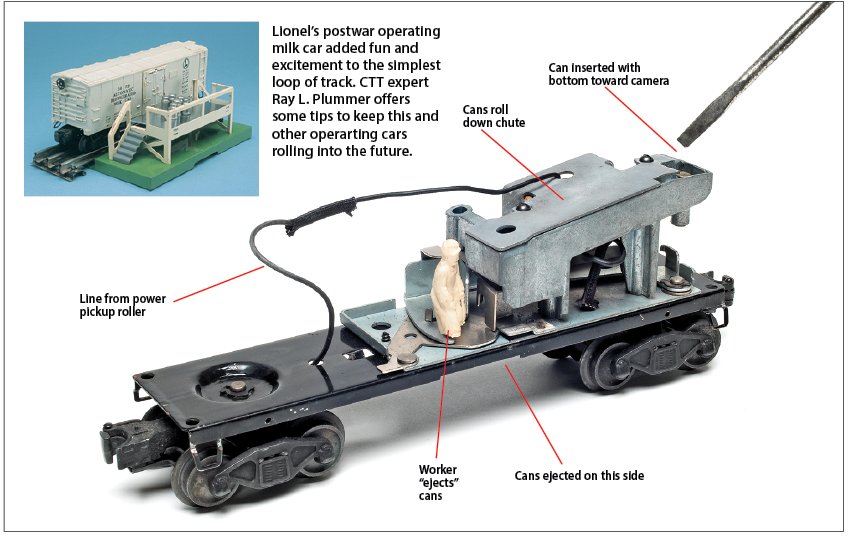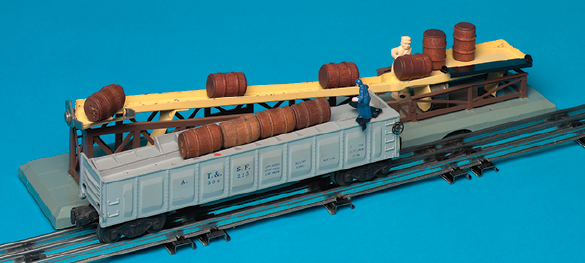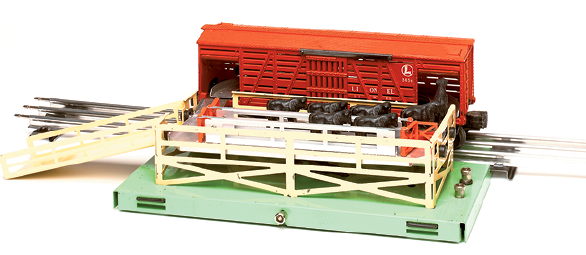A version of this article originally appeared in the January 2011 issue of Classic Toy Trains.
If there is one restoration question that repeatedly gets asked of us at Classic Toy Trains, it is some aspect of repairing or tweaking one of Lionel’s postwar operating cars. Introduced more than 60 years ago, the nifty little cars added a dimension of fun to O gauge layouts across America.
These cars were popular then, and they still have an enthusiastic following! Here are some tips to keep some of your more popular cars running.
Operating milk car
Operation: A large solenoid and plunger is linked to the mechanical moving parts of the car. The solenoid coil pushes the plunger out. The figure then appears to eject one milk can.
Troubleshooting: Does not operate: Wire insulation is often hardened, cracked, or broken. Replace all the wiring, from the trucks to the solenoid. That eliminates potential short circuits before they can happen.
Sticking solenoid plunger: Spray TV tuner cleaner directly into the solenoid tube. Work the plunger by hand until the action loosens up. Don’t lubricate the plunger with anything. Solenoid return springs sometimes lose resiliency over time, causing the return action to be sluggish or incomplete. In may cases, this can be corrected by gently stretching the spring to increase tension.
Missing doors: Later plastic doors were more fragile and prone to break. Both metal and plastic types used tiny coil springs to keep the doors closed. These tend to pop out and get lost. Replacements are available, but installing them is a job for three hands and a bottle of aspirin.
Rough deck surface: Rub the platform plate with automotive chrome polish to make it shiny and smooth. This will remove superficial rust in the process. Badly rusted or pitted plates will interfere with the operation of the car. Aftermarket replacements are available.
General maintenance: You can’t cover all the problems that can arise in a mechanism with as many levers, arms, pivots, and cams as the milk car. If the car doesn’t work as it should, begin by brushing the entire mechanism with a solvent, such as mineral spirits, to remove the accumulation of dirt and grease. Do this in a well-ventilated area and allow the part to dry.
Lubricate all pivoting points with a drop of Lionel lube or a lightweight oil. Powdered lubricants (graphite or Teflon) may be used on sliding surfaces.
Malfunctions may be due to bent or distorted parts, burred edges, or rivets that are too tight or loose. Carefully move the plunger back and forth manually to discover the places where interference or binding may be occurring. Bend and straighten, as needed.
Searchlight cars
Operation: Searchlight housing moves due to vibrotor motor.
Troubleshooting: Light won’t rotate: If the driving washer has worn or broken fingers, replace. Affix the washer in place using a drop or two of an adhesive. Also check the fiber board upon which the switch mechanism is built and attached to the underside of the car. If the nut is loose, tighten by gently tapping it with a punch and hammer.
Flickering light: Check the switch contacts or the power pickup roller. Clean these by spraying the roller or switch contacts with TV tuner cleaner.
Unreliable operation: Check the return spring on the switch mechanism – it may break or pop out of place. If the spring is out of place, return its end to its mooring hole and apply a few drops of epoxy cement to keep it in place. If the spring is broken, replace it.
Light rotates, but doesn’t illuminate: Check bulb for proper fit and replace if burned out.
Barrel loader nos. 362 and 3562
Operation (barrel loader): Vibration of the spring-mounted ramp propels wooden barrels up and off the ramp.
Troubleshooting: Generally reliable, though dirt and debris can impede performance. Be sure the ramp is clean. Clean the ramp and barrels lightly with alcohol or mineral spirits.
Operation (barrel car): Like the loader, operation stems from vibration of a spring-mounted platform.
Troubleshooting: Doesn’t work, or operation erratic: Check for worn-out wires from the contact shoes on the trucks to the coil. Replace as needed.
Speed too fast/slow: Adjust the action by loosening the coil housing screws under the car and moving the coil.
Barrel movement sluggish: Cleaning will keep the conveyor channel open and freely running. Use alcohol or mineral spirits on a swab or cloth.
Operating stockcar
Operation: Vibrating action of corral and car floor causes the cattle to move. Position of sliding door on opposite side of car determines whether cattle load or unload.
General maintenance: Solenoids and bridges between the car and corral need occasion-al adjustment. Keep power pickup shoes clean and the car and platform free of oil, dust, and dirt. The runway inside the car needs to be smooth. Shine with Scotch-Brite pad.
Troubleshooting: Car or platform solenoid doesn’t work: Check wires for damage or bad insulation.
Platform/car vibration insufficient to move cattle: Replace the six sponge rubber pads (three in car, three on platform). You may need to readjust the vibration solenoid and spring lever with new pads until car and corral vibrations match for synchronized operation.
Entry/exit doors don’t open: Check end pivots. If doors are warped, sand or file lightly until they move freely.
Cattle won’t stay in car: Tighten keeper arm on sliding door.
Cattle refuse to enter/exit car: Adjust bridge tabs by bending them slightly until the ac-tion is satisfactory and the cattle move smoothly.
Operating boxcars
Operation: A simple, spring-loaded plunger and release mechanism is activated, causing the door to open and a figure to appear.
Troubleshooting: Springs brittle or lose their resiliency: Buy and install replacement springs.
Plastic trigger housing shrinks: Tighten with a few drops of epoxy cement.
Sluggish doors: Clean out guide slots with toothpick, then apply small bit of powdered lubricant such as Teflon.
General lubrication: Lubricate the two pivots inside the car with a drop of oil. The slot in the cam lever and the small area of the car floor should have a light film of grease. Use lubricants sparingly.

















The plate that pushes the cans out from the drop doesn’t seem to have an interest in returning to its position to allow the next can.to drop. Any suggestions? Do the newer cars have an improved mechanism?
Very basic stuff but this reminds you of something you may have overlooked. Very glad they said “”No lubricant in the solenoid” on the milk car: that’s probably the most common error someone could do to a milkcar.